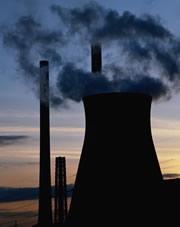Until now, it was accepted that soot somewhat balances the greenhouse gases and cools the earth, but a study by Weizmann Institute of Science scientists reveals otherwise

Tons of soot are released into the atmosphere every year as a result of forest fires that occur in California, the Amazon Valley, Siberia and Indonesia, among others. Until now, climate researchers believed that the smoke from the fires causes cooling, since the soot particles in the smoke reflect some of the sun's radiation back into space. In addition, these particles cause the cloud cover to expand and extend the length of their "life" - and the clouds also return solar radiation to space. But a new study by scientists from the Weizmann Institute of Science, who worked in collaboration with scientists from the University of Maryland, and the US space agency, NASA, discovered that the soot in smoke plays a more complex role in shaping the Earth's climate.
Particles like soot that float in the air - called aerosols - rise in the atmosphere where they mix with clouds. The processes involved in the encounter between the aerosols and the clouds are particularly complex because the clouds are very dynamic systems. On the one hand, they return the sun's radiation to space (which causes the climate to cool), and on the other hand, they trap heat emitted from the face of the Earth and prevent it from being released - which causes the climate to warm. Therefore, the effect of the aerosols on the clouds may cause warming and cooling at the same time. On the one hand, water droplets can condense around the aerosol particles, which results in extending the life of the cloud and increasing their coverage area. On the other hand, particles, especially soot, absorb radiation from the sun, which causes warming, and inhibits the development of clouds.
Dr. Ilan Koren and research student Hila Efragon from the Department of Environmental Sciences and Energy Research at the Weizmann Institute of Science, who worked in collaboration with scientists from the University of Maryland and NASA, developed a first-of-its-kind computational model that combines and weighs all these factors and shows under what conditions the aerosols that mix in the clouds will cause climate warming, And when will they actually cause cooling. The model, into which data from the Amazon Valley was entered, accurately predicted the state of the clouds in reality.
These findings, published today in the scientific journal Science, show that when small amounts of aerosols are added to a clean environment - the result will be a cooling of the climate. But as the amount of aerosols that mix in the clouds increases, the result is a warming of the climate.
It also turns out that the extent of the original cloud cover also affects the process. Extensive cloud cover blocks the sun's rays, so that the aerosol particles do not absorb the radiation, which can stimulate further cooling. But as the parts of the clear sky are wider, the aerosol particles absorb more radiation, which accelerates the warming.
An accurate quantitative model of the complex interrelationships between clouds and aerosols is still missing in the "puzzle" of the picture of climate changes caused by man, or as a result of natural processes occurring on the surface of the earth. The scientists believe that the additional understanding resulting from the new model they developed may help policy makers to more accurately estimate the effects of these processes on the climate.
